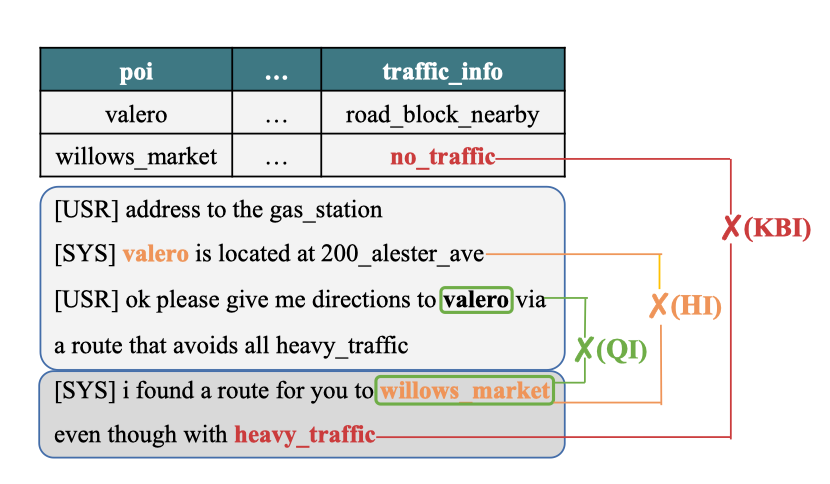GD-VCR
Code for Broaden the Vision: Geo-Diverse Visual Commonsense Reasoning (EMNLP 2021).
Research Questions and Aims:
- How well can a model perform on the images which requires geo-diverse commonsense to understand?
- What are the reasons behind performance disparity on Western and non-Western images?
- We aim to broaden researchers' vision on a realistic issue existing all over the world, and call upon researchers to consider more inclusive commonsense knowledge and better model transferability on various cultures.
In this repo, GD-VCR dataset and codes about 1) general model evaluation, 2) detailed controlled experiments, and 3) dataset construction are provided.
Repo Structure
GD-VCR
├─X_VCR --> storing GD-VCR/VCR data
├─configs
│ └─vcr
│ └─fine-tune-qa.json --> part of configs for evaluation
├─dataloaders
│ └─vcr.py --> load GD-VCR/VCR data based on configs
├─models
│ └─train.py --> fine-tune/evaluate models
│
├─val.jsonl --> GD-VCR dataset
├─val_addition_single.jsonl --> additional low-order QA pairs
GD-VCR dataset
First download the original VCR dataset to X_VCR:
cd X_VCR
wget https://s3.us-west-2.amazonaws.com/ai2-rowanz/vcr1annots.zip
wget https://s3.us-west-2.amazonaws.com/ai2-rowanz/vcr1images.zip
unzip vcr1annots.zip
unzip vcr1images.zip
Then download the GD-VCR dataset to X_VCR:
cd X_VCR
mv val.jsonl orig_val.jsonl
wget https://gdvcr.s3.us-west-1.amazonaws.com/MC-VCR_sample.zip
unzip MC-VCR_sample.zip
cd ..
mv val.jsonl X_VCR/
mv val_addition_single.jsonl X_VCR/
The detailed items in our GD-VCR dataset are almost the same as VCR. Please refer to VCR website for detailed explanations.
VisualBERT
Prepare Environment
Prepare environment as mentioned in the original repo of VisualBERT.
Fine-tune model on original VCR
Download the task-specific pre-trained checkpoint on original VCR vcr_pre_train.th to GD-VCR/visualbert/trained_models.
Then, use the command to fine-tune:
export PYTHONPATH=$PYTHONPATH:GD-VCR/visualbert/
export PYTHONPATH=$PYTHONPATH:GD-VCR/
cd GD-VCR/visualbert/models
CUDA_VISIBLE_DEVICES=0 python train.py -folder ../trained_models -config ../configs/vcr/fine-tune-qa.json
For convenience, we provide a trained checkpoint [Link] for quick evaluation.
Evaluation on GD-VCR
CUDA_VISIBLE_DEVICES=0 python train.py -folder ../trained_models -config ../configs/vcr/eval.json \
[-region REGION] \
[-scene SCENE] \
[-single_or_multiple SINGLE_OR_MULTIPLE] \
[-orig_or_new ORIG_OR_NEW] \
[-addition_annotation_analysis] \
[-grounding]
Here are the explanations of several important attributions:
REGION: One of the regionswest,east-asia,south-asia,africa.SCENE: One of the scenario (e.g.,wedding).SINGLE_OR_MULTIPLE: Whether studyingsingle(low-order) ormultiple(high-order) cognitive questions.addition_annotation_analysis: Whether studying GD-VCR or additional annotated questions. If yes, you can choose to setSINGLE_OR_MULTIPLEto specify which types of questions you want to investigate.ORIG_OR_NEW: Whether studying GD-VCR or original VCR dev set.grounding: Whether analyzing grounding results by visualizing attention weights.
Given our fine-tuned VisualBERT model above, the evaluation results are shown below:
| Models | Overall | West | South Asia | East Asia | Africa |
|---|---|---|---|---|---|
| VisualBERT | 53.27 | **62.91** | 52.04 | 45.39 | 51.85 |
ViLBERT
Prepare Environment
Prepare environment as mentioned in the original repo of ViLBERT.
Extract image features
We make use of the docker made for LXMERT. Detailed commands are shown below:
cd GD-VCR
git clone https://github.com/jiasenlu/bottom-up-attention.git
mv generate_tsv.py bottom-up-attention/tools
mv generate_tsv_gt.py bottom-up-attention/tools
docker pull airsplay/bottom-up-attention
docker run --name gd_vcr --runtime=nvidia -it -v /PATH/TO/:/PATH/TO/ airsplay/bottom-up-attention /bin/bash
[Used to enter into the docker]
cd /PATH/TO/GD-VCR/bottom-up-attention
pip install json_lines
pip install jsonlines
pip install python-dateutil==2.5.0
python ./tools/generate_tsv.py --cfg experiments/cfgs/faster_rcnn_end2end_resnet.yml --def models/vg/ResNet-101/faster_rcnn_end2end_final/test.prototxt --out ../vilbert_beta/feature/VCR/VCR_resnet101_faster_rcnn_genome.tsv --net data/faster_rcnn_models/resnet101_faster_rcnn_final.caffemodel --total_group 1 --group_id 0 --split VCR
python ./tools/generate_tsv_gt.py --cfg experiments/cfgs/faster_rcnn_end2end_resnet.yml --def models/vg/ResNet-101/faster_rcnn_end2end_final/test_gt.prototxt --out ../vilbert_beta/feature/VCR/VCR_gt_resnet101_faster_rcnn_genome.tsv --net data/faster_rcnn_models/resnet101_faster_rcnn_final.caffemodel --total_group 1 --group_id 0 --split VCR_gt
[Used to extract features]
Then, exit the dockerfile, and convert extracted features into lmdb form:
cd GD-VCR/vilbert_beta
python script/convert_lmdb_VCR.py
python script/convert_lmdb_VCR_gt.py
Fine-tune model on original VCR
Download the pre-trained checkpoint to GD-VCR/vilbert_beta/save/bert_base_6_layer_6_connect_freeze_0/.
Then, use the command to fine-tune:
cd GD-VCR/vilbert_beta
python -m torch.distributed.launch --nproc_per_node=8 --nnodes=1 --node_rank=0 train_tasks.py --bert_model bert-base-uncased --from_pretrained save/bert_base_6_layer_6_connect_freeze_0/pytorch_model_8.bin --config_file config/bert_base_6layer_6conect.json --learning_rate 2e-5 --num_workers 16 --tasks 1-2 --save_name pretrained
For convenience, we provide a trained checkpoint [Link] for quick evaluation.
Evaluation on GD-VCR
CUDA_VISIBLE_DEVICES=0,1 python eval_tasks.py
--bert_model bert-base-uncased
--from_pretrained save/VCR_Q-A-VCR_QA-R_bert_base_6layer_6conect-pretrained/vilbert_best.bin
--config_file config/bert_base_6layer_6conect.json --task 1 --split val --batch_size 16
Note that if you want the results on original VCR dev set, you could directly change the "val_annotations_jsonpath" value of TASK1 to X_VCR/orig_val.jsonl.
Given our fine-tuned ViLBERT model above, the evaluation results are shown below:
| Models | Overall | West | South Asia | East Asia | Africa |
|---|---|---|---|---|---|
| ViLBERT | 58.47 | **65.82** | 62.90 | 46.45 | 62.04 |
Dataset Construction
Here we provide dataset construction methods in our paper:
similarity.py: Compute the similarity among answer candidates and distribute candidates to each annotated questions.relevance_model.py: Train a model to compute the relevance between question and answer.question_cluster.py: Infer question templates from original VCR dataset as the basis of annotation.
For sake of convenience, we provide the trained relevance computation model [Link].
Acknowledgement
We thank for VisualBERT, ViLBERT, and Detectron authors' implementation. Also, we appreciate the effort of original VCR paper's author, and our work is highly influenced by VCR.
Citation
Please cite our EMNLP paper if this repository inspired your work.
@inproceedings{yin2021broaden,
title = {Broaden the Vision: Geo-Diverse Visual Commonsense Reasoning},
author = {Yin, Da and Li, Liunian Harold and Hu, Ziniu and Peng, Nanyun and Chang, Kai-Wei},
booktitle = {EMNLP},
year = {2021}
}



